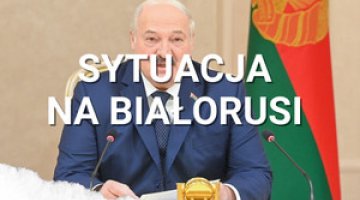The story that never ends. A new stage in the energy dispute between Russia and Belarus

The energy sector is an essential area in Russian-Belarusian relations. Belarus is almost totally dependent on oil and gas supplies from Russia, and preferential prices are necessary for Minsk to maintain its outdated economic model and social stability. Russia in turn has used the mechanism of subsidising Belarus as a means to bolster its political influence. The disagreements between Minsk and Moscow over the rules of co-operation and oil and gas prices provoke regular disputes on the subject of energy.
Over the past few years, the situation in the area of energy co-operation has become more strained due to Russia’s desire to optimise the costs of supporting its Belarusian ally alongside its growing disappointment with this ally’s disloyalty. This has been accompanied by the escalating recession on the Belarusian economy forcing the Belarusian government to apply for more and more subsidies. As a result, another Russian-Belarusian energy dispute has been escalating since the beginning of 2016, turning into an unprecedentedly long and profound crisis extending over almost all aspects of co-operation between the two countries. In April this year, the two parties developed a package of agreements regulating most of the problems, most importantly this includes the conditions of oil and gas supplies in the coming years. However, in practice, many issues remain unclear, and this creates room for further conflicts. Moscow and Minsk are moderately satisfied with the deal and treat it as a temporary compromise. It is clear that the two parties do not trust one another and have conflicting goals. Belarus still hopes for significantly higher subsidies, but is attempting to assert its independence in domestic and foreign policy. In turn, the Kremlin, which has been reducing the subsidies, would only be ready to increase its support at the price of Minsk becoming unconditionally subordinate to Moscow.
The background of the dispute
The heavy reliance of the Belarusian economy on oil and gas supplies from Russia is the source of all the Russian-Belarusian oil and gas disputes. Russia supplies 100% of Belarus’s natural gas imports. As a result, gas prices are essential for the profitability of the predominantly outdated industry in Belarus, a section of which (for example, nitrate and potassium factories) uses it in the production cycle. Russia supplies over 90% of the Belarusian consumption of oil. Although Belarus has for years extracted around 1.6 million tonnes of oil annually from its own reserves, all of its output is exported, mainly to Germany. Belarusian refineries are thus entirely dependent on Russian supplies. As recently as in 2015, 25% of Belarus’s total export incomes were generated by the sale of Belarusian petroleum products. As a result, the petrochemical sector is of strategic significance for the state of the Belarusian economy as a whole. At the same time, Belarus, regardless of its numerous attempts in the past to diversify the sources of oil and gas supplies, has been unable to find an alternative to Russian supplies at an acceptable price. Furthermore, this seems to be an impossible goal in the short and medium term.
Belarus’s energy dependence on Russia fits in the context of the complicated relations between the two countries in which Moscow wishes to completely subordinate Minsk and to force it to make strategic concessions emphasising its complete loyalty to Moscow. Moscow’s insistence (repeated since autumn 2015) on Minsk’s consent to deploy a Russian military airbase near Bobruysk serves as one example of this. Furthermore, the Kremlin expects Minsk to become fully engaged in the process of integration as part of the Eurasian Economic Union (EAEU) and to back its moves with regard to Ukraine. At the same time, Moscow is trying to optimise its costs of subsidising the Belarusian economy and has been regularly reducing its support for Belarus over the past few years (according to the International Monetary Fund’s report, the value of the subsidies in 2013 was equivalent to almost 20% of Belarus’s GDP, while in 2015 it was only slightly over 10%)[1]. Meanwhile President Alyaksandr Lukashenka, making efforts to receive subsidies at the highest possible level, has also been trying to avoid making serious political concessions.
The long road to compromise
The most recent energy dispute began when Belarus, referring to its EAEU membership, concluded that it had the right to internal Russian prices which were much lower than those offered to foreign buyers. As a result, since January 2016, Minsk has paid a price it unilaterally reduced to US$80-107 per 1000 m3 for its gas supplies instead of US$132–141[2] derived from the price formula in the binding contract with Gazprom. The Russian side did not accept this argumentation, and so the debt was accumulating at a regular rate, reaching US$726 million by April this year. Russia, in an attempt to force Belarus pay this debt, since June 2016 has reduced oil supplies to Belarusian refineries from the total planned annual volume of 24 million tonnes to 18 million tonnes. Although representatives of the two countries announced on 10 October 2016 that a deal had been struck, it became clear a few weeks later that the deal had not been implemented. Furthermore, more issues were added to the catalogue of disagreements between Minsk and Moscow, such as the status of the border between the two countries, border control procedures and access to the Russian market for Belarusian food products (above all meat and dairy products). In addition to this, the Moscow-controlled Eurasian Fund for Stabilisation and Development froze further availability of the credit facility offered to Belarus worth US$2 billion.
In addition to this, the Russian press has have waged an increasingly aggressive propaganda campaign since last autumn questioning the loyalty of Alyaksandr Lukashenka to his Russian ally[3] and suggesting that this might lead to a repeat of the violent Ukrainian scenario in Belarus[4]. The dispute reached its peak when Alyaksandr Lukashenka, irritated by Moscow’s confrontational stance, boycotted the summit of the leaders of the EAEU and the Collective Security Treaty Organisation on 26 December 2016 in Saint Petersburg. By doing this he openly manifested his growing dissatisfaction with the lack of the expected benefits from the participation in the integration processes in the post-Soviet area initiated by Moscow[5]. In effect, Belarus did not sign the Customs Code of the EAEU[6], which in practice meant it blocked an important stage in the process of the construction of this integration structure.
All the talks that took place in the first quarter of this year were unsuccessful. At the same time, the schedule of oil supplies in the first months of 2017 suggested that Belarus would receive only 16 million tonnes of oil this year, i.e. 2 million tonnes less than last year. It appeared then that Russia was intentionally delaying resolving this conflict while also escalating it in order to force the Belarusian government to make concessions. The Belarusian side’s stance was simultaneously becoming decreasingly flexible—one manifestation of this was its refusal to recognise the existence of the aforementioned gas debt[7]. It was only as a result of the meeting of the presidents of Russia and Belarus on 3 April in Saint Petersburg that a political deal setting the rules of co-operation in the oil and gas sector was struck[8].
Belarusian concessions and Russian undertakings
The sequence of developments clearly indicates that the concessions Belarus made in two disputed issues which Moscow views as fundamental is the necessary condition for the implementation of the political arrangements made by the two leaders on 3 April. On 12 April, the Belarusian side repaid the debt of US$726 million in full. On the same day, Lukashenka signed the Customs Code of the EAEU. Two days later he took part in an informal summit of the presidents of the EAEU member states in Bishkek, where he did not question the concept of Belarus’s further participation in the EAEU[9]. On 13 April, the Kremlin agreed to approve a package of agreements offering Belarus a number of the following benefits:
Firstly, Moscow has agreed to return the volume of oil supplies to Belarus to 24 million tonnes annually; this level of supplies will be binding up to and including 2024. The current schedule of quarterly supplies envisages that Russian oil exports will increase from 4 million tonnes in the first quarter of 2017 to 5 million tonnes in the second quarter, while in the second half of 2017 the supplies will reach 15 million tonnes.
Secondly, the Russian side has agreed to lift the obligation for Belarus to supply 1 million tonnes of petroleum products annually to Russia. According to the Belarusian deputy prime minister, Uladzimir Semashko, Minsk might earn an additional US$150 million annually by exporting its own petroleum products to more profitable markets[10].
Thirdly, Russia has agreed to offer Belarus loans worth a total of US$1.6 billion, including US$1 billion directly from Russia and the rest from the credit facility offered as part of the Eurasian Fund for Stabilisation and Development[11].
Fourthly, it has been finally agreed that Gazprom will reduce the gas price for Belarus in 2018–2019 by around 20%, i.e. to the level of around US$130 per 1000 m3 (according to Deputy Prime Minister Semashko, US$129 per 1000 m3 in 2018 and US$127 per 1000 m3 in 2019)[12].
Who has won, who has lost?
Even though the list of undertakings regarding energy issues is longer on the Russian side, it seems that the deals struck are merely an illusory success for Minsk.
Firstly, it is unclear in what manner the arrangements concerning gas co-operation will finally be implemented. According to assurances from Russia, it will supply oil in 2018–2019 on conditions that will guarantee a price of around US$130 per 1000 m3. This means that the final price differs significantly from Belarus’s initial demands (US$72–80 per 1000 m3, and US$100–107 per 1000 m3 at a later stage of the negotiations). Furthermore, it is unclear whether the assumptions stated in the intergovernmental protocols will be put into effect. It can be concluded from the arrangements that the guaranteed price will be an effect of changes in the price formula in the contract between Belarus and Gazprom. The three-year Russian-Belarusian contract concerning Russian gas supplies to Belarus will have expired by the end of 2017, and it is not entirely clear whether and to what extent the political arrangements will be implemented in the new contract. It may also be concluded from press reports that a clause enabling the emergence of suppliers in Belarus other than Gazprom (alongside export prices and domestic prices on the Russian market being brought to the same level) has been removed on the grounds of the protocols signed. This will make it difficult for Belarus to diversify gas supplies.
Secondly, it is not entirely clear in the case of oil co-operation how much of the supplied Russian oil Belarus will be able to use for manufacturing petroleum products at its own refineries. On the one hand, it can be concluded from a statement by the Russian minister for energy, Alexander Novak, that Belarus will be able to dispose of the oil supplied by Russia with no restrictions[13]. On the other hand, the Russian deputy prime minister, Arkady Dvorkovich, suggested that only 18 out of the 24 million tonnes of oil could be allocated for the needs of processing at Belarusian refineries, while the remaining 6 million tonnes could only be re-exported. This second variant would de facto mean the level of crude oil processing output would be maintained on the same level as last year, which was around 6 million tonnes lower than in 2015 (i.e. far below the production capacity of the modernised Belarusian refineries). The reduction of supplies last year resulted in a US$1.2 billion reduction in revenue from the export of petroleum products[14] and a 19% fall of the oil sector’s output[15]. At the same time, according to calculations by Russian experts, at a price of US$55 per barrel, Belarus could earn around US$570 million annually on exporting 6 million tonnes of Russian oil. It is thus difficult to say that the losses resulting from cutting supplies to Belarusian refineries will be compensated to a significant extent.
The Belarusian oil sector will find the successive implementation of the so-called ‘tax manoeuvre’ in Russia since 1 January 2015 an additional challenge. It involves the gradual reduction of the export duty on crude oil (from 59% in 2014 to 30% in 2017), while the production tax rate (known as NDPI in Russia) has been growing – from 419 roubles per tonne of oil in 2014 to 919 roubles per tonne in 2017. This means that Belarusian refineries are already receiving a more expensive raw material, and the higher prices are not compensated in this case by Russia’s lifting the export duty on oil. Given this situation, the Belarusian government is somewhat distrustful about the negotiated deals and is looking for possibilities to diversify its oil supplies. On 5 May this year, the president of the Belarusian oil company Belneftekhim, Ihar Lyashenka, announced that talks with “other partners from other regions” were underway, but he did not precisely state which suppliers he meant[16]. Furthermore, energy security, including increasing exports of Belarusian petroleum products to the Ukrainian market, was one of the key issues of Alyaksandr Lukashenka’s meeting with President Petro Poroshenko on 26 April[17].
Thirdly, it is uncertain when and on what conditions Belarus will receive the loan of US$1 billion promised during the negotiations in April this year. There is no information that any formal deal has been struck regarding this issue. Therefore, this is an initial suggestion of a potential loan support at best. It is also unclear whether the stabilisation programme of the Eurasian Fund for Stabilisation and Development will be continued. The third instalment of US$300 million was transferred at the end of April this year, even though Belarus had failed to meet part of the macroeconomic requirements of the fund, was according to a political decision by the Kremlin. However, the availability of further instalments was conditioned by meeting a number of requirements, including the launch of the privatisation of state-owned industrial facilities on a larger scale[18]. This is a controversial issue for Minsk. Therefore delays in transferring the funds from the fund should be expected at the least.
Conclusions and forecast
It seems that both presidents have decided to strike a deal under the influence of the current situation which forces them to make concessions in order to de-escalate the tension which is dangerous for the further functioning of the present model of co-operation. It may be assumed that the public protests are the main factor which has persuaded Lukashenka to strike the deal with Russia. For the first time in many years these were seen across the country and were to a great extent a result of the dissatisfaction of ordinary citizens with the long-lasting economic recession and the deterioration of the living standards it entailed[19]. Although strong reactions from the government led to a mitigation in the wave of protests towards the end of March, the factors which provoked the protests have not been resolved. Given this situation, a further escalation of the conflict with Russia might lead to a complete economic collapse, and thus to the risk of an outburst of public dissatisfaction on a scale difficult to cope with, even for an authoritarian regime which is rather skilful in the use of repression.
Moscow was interested in resolving the dispute on conditions that would on the one hand maintain Belarus’s political and economic dependence on Russia, and on the other would not require Russia to incur excessive financial costs. Nor should it be ruled out that the Kremlin wanted to avoid Minsk blocking the EAEU Customs Code from entering into force. For Vladimir Putin such a visible failure in the process of reintegration of the post-Soviet area would be a serious reputation problem in the context of the presidential election scheduled for next year in Russia.
The deals have consolidated Belarus’s energy dependence on Russia, which is one of the key goals of Moscow’s strategy towards Minsk. This allows it to successfully use oil and gas as an instrument in political relations. In turn, Belarus may (assuming that the Kremlin’s measures will be fully implemented) at least temporarily stabilise its economic situation. However, it seems that neither of the parties has achieved its main goal. On the one hand, the level of Russian supplies is much lower than Minsk expected. On the other, Belarus has not made any concessions that would be satisfactory to Moscow (for example, consent to deploy the military airbase near Bobruysk). It should thus be expected that the deals will not last long, especially given the fact that not all the disputed issues have been resolved (the border issue, export of Belarusian food products to Russia, etc.). This means that a further political crisis with much more serious implications for Belarus cannot be ruled out.
[1] For more information see: https://www.imf.org/external/pubs/ft/scr/2016/cr16298.pdf
[2] After a year or so of the dispute, both Belarus and Russia have based their calculations on various rates within the indicated price ranges. Regardless of this, a significant difference between the calculations made by the two parties continued over this entire period.
[3] In Russia’s opinion, Minsk’s policy towards Kyiv has been overly neutral and it has refrained from clearly supporting the Russian moves against Ukraine, such as the annexation of Crimea or supporting the two self-proclaimed republics in the Donbas.
[4] For more information see: Kamil Kłysiński, ‘The risk of escalating tensions in Minsk-Moscow relations’, OSW Analyses, 4 January 2017, https://www.osw.waw.pl/en/publikacje/analyses/2017-01-04/risk-escalating-tensions-minsk-moscow-relations.
[5] Over the past year or so, the Belarusian president has criticised the EAEU (and thus Russia, which dominates this structure) in public on numerous occasions for failing to offer equal conditions to all member states of the union. See: Лукашенко вновь раскритиковал ЕАЭС за изъятия, ограничения и отсутствие равных условий, https://news.tut.by/economics/498581.html; Марина Носова, Лукашенко: Давления со стороны России ни я, ни белорусы не потерпят, http://naviny.by/article/ 20160920 /1474375596-lukashenko-davleniya-so-storony-rossii-ni-ya-ni-belorusy-ne-poterpyat.
[6] This document will replace the Customs Code already adopted as part of the Customs Union in 2009.
[7] For more information see: Белоруссия отказалась признавать долг за газ перед Россией, https://lenta.ru/news/2017/03/31/belrusgas/
[8] For more information see: http://kremlin.ru/events/president/news/54178
[9] For more information see: Беларусь предлагает реализовать комплекс действенных мер для более быстрого становления ЕАЭС, http://www.belta.by/president/view/belarus-predlagaet-realizovat-kompleks-dejstvennyh-mer-dlja-bolee-bystrogo-stanovlenija-eaes-242704-2017/
[10] Белоруссию освободят от обязательных поставок бензина в Россию, http://1prime.ru/articles/20170407/827341070.html
[11] Россия даст $1 млрд долларов Белоруссии на оплату долга за газ, http://1prime .ru/News/20170410/827345755.html; Беларусь получила 300 млн долларов от Евразийского фонда стабилизации и развития, http://naviny.by/new/20170426/1493213123-belarus-poluchila-300-mln-dollarov-ot-evraziyskogo-fonda-stabilizacii-i
[12] «Газпром» дал скидку Белоруссии, http://www.kommersant.ru/doc/3270189
[13] Новак: Минск сам определит объем переработки из 24 млн т беспошлинной российской нефти, http://1prime.ru/oil/20170414/827367787.html
[14] For more information see: Газовые бонусы для Беларуси: все зависит от мировой цены на нефть, http://www.belrynok.by/2017/04/18/gazovye-bonusy-dlya-belarusi-vse-zavisit-ot-mirovoj-tseny-na-neft/.
[15] Data on the basis of the official statement from the Belarusian company Belneftekhim on the results of its operation in 2016. For more information see: «Белнефтехим» подвел итоги 2016 года: переработка нефти в минувшем году снизилась на 19%, http://www.belrynok.by/ru/page/news/4647/
[16] For more information see: "Белнефтехим" ведет переговоры по диверсификации поставок нефти, http://www.belta.by/economics/view/belneftehim-vedet-peregovory-po-diversifikatsii-postavok-nefti-245941-2017/
[17] For more information see: Беларусь увеличит поставки нефтепродуктов в Украину, заявил Порошенко, http://naviny.by/new/20170426/1493223438-belarus-uvelichit-postavki-nefteproduktov-v-ukrainu-zayavil-poroshenko; Пугало Майдана спрятано. Лукашенко и Порошенко пересеклись в зоне, http://naviny.by/article/20170426/1493227891-pugalo-maydana-spryatano-lukashenko-i-poroshenko-pereseklis-v-zone.
[18] For more information see: Минску выставлены новые условия получения евразийского кредита, http://naviny.by/article/20170427/1493318497-minsku-vystavleny-novye-usloviya-polucheniya-evraziyskogo-kredita
[19] The move which triggered the demonstrations was the presidential decree “on counteracting social parasitism”. For more information see: Kamil Kłysiński, ‘Demonstracje na Białorusi’, OSW Analyses, 27 March 2017, https://www.osw.waw.pl/pl/publikacje/analizy/2017-03-27/demonstracje-na-bialorusi




